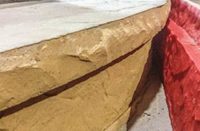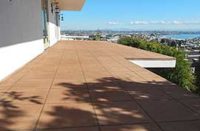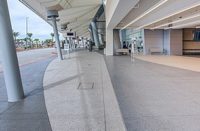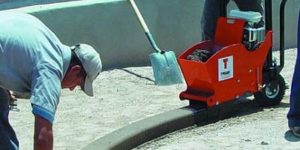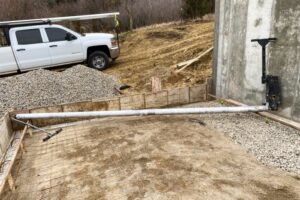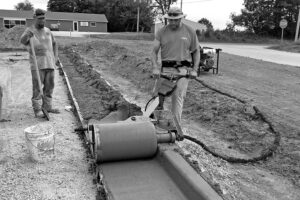 Here’s are some possibilities for adding value to edging, borders, curbs and gutters with decorative concrete techniques – From a border around a flowerbed, parking lot, sidewalks in a new subdivision, or a full-on highway project.
Here’s are some possibilities for adding value to edging, borders, curbs and gutters with decorative concrete techniques – From a border around a flowerbed, parking lot, sidewalks in a new subdivision, or a full-on highway project.
In your work, you may have encountered concrete edging, curbs and gutters on several scales — a border around a flowerbed, curbs and stops in a parking lot, sidewalks in a new subdivision, or a full-on highway project. Here’s a look at some of the possibilities for adding value to these projects with decorative techniques.
Curbs in new places
Concrete curbs are familiar sights by the street or in a parking lot, but landscape curbs are growing in popularity around North America. Concrete curbs around garden beds serve several functions. They retain water in the bed. They prevent mulch and stone from escaping onto the lawn or sidewalk. They keep weeds from invading the bed from the lawn. And with an L-shaped curb profile facing the lawn, you can mow right up to the edge. It’s no wonder that these curbs exert a powerful effect on neighbors, who begin calling to get estimates of their own once the first house has been done in a neighborhood.

If landscape concrete curbs are popular in your town, or you’d like to make them so, check out small slipforming machines, which are much easier to use than wooden forms or even reusable flexible forms. The Kwik Kerb machine, from Edgemaster, and the Lil’ Bubba, from The Concrete Edge Company, lend themselves not only to residential work around curved garden beds and walkways but also to commercial parking lots.
The small machines can extrude concrete curbs on a paved surface or on compact soil. On a paved surface, the curb can be extruded over rebar spikes, lengthwise rebar, or epoxy adhesive.

If the site is grassy, the sod must be removed, and the best method for that depends on the type of grass
characteristic of your area. You can use a sod cutter to scalp off the sod, which you then roll up for disposal. You can also use a bed edger, which grinds up the sod and deposits it on the bed side of the curb.
Once the surface is ready, you affix the desired mold to the machine, dump in concrete from a mixer, and start extruding away. An auger or plunger forces the zero-slump mix through the mold. Where the curb begins and ends, it must be troweled by hand. Cut a control joint by hand every three or four feet, depending on how cold it gets in your area.
| Help for small contractors Some contractors find it profitable to specialize in landscape curbs and parking lot jobs, and wish to market themselves in that niche. To contractors who buy a whole package of equipment and training, Edgemaster offers the option of branding themselves with the Kwik Kerb name. There are no licensing fees. Benefits include roll-out advertising in your area and Kwik Kerb’s continuous advertising in consumer publications.It is also possible to buy an Edgemaster machine without the branding program. Likewise, the Concrete Edge offers single Lil’ Bubba machines or turnkey packages with training and supportive advertising materials, without the branding aspect. |
Decorative effects
Like control joints and ends, decorative patterns or textures must be created by hand. Both Edgemaster (Kwik Kerb) and The Concrete Edge (Lil’ Bubba) supply equipment for this. The Concrete Edge offers tools and materials for troweling overlays on their curbs and then stamping them, or stamping the concrete itself, whereas Edgemaster offers only tools for stamping the curbs themselves.
Exposed aggregate effects are possible. The Lil’ Bubba normally uses a mix that contains glass fiber instead of stone, but it can accommodate gravel up to 3⁄8″, as can the Kwik Kerb. The surface is troweled to bring up the cement, then sprayed with retardant. When the uncured surface cement is washed away, the aggregate is exposed.
The Lil’ Bubba can extrude a walkway as wide as 24″. And suppose that walkway needs to be lighted? Both Kwik Kerb and Lil’ Bubba machines can extrude a curb with a groove in which you can install a strip of low-voltage lamps. An alternative to electric lights is Allumagel, a glow-in-the-dark coating, similar to a fiberglass gel coat. Applied to curbs, it will glow for twelve hours after sundown. Edgemaster plans to start distributing this coating later this year.
Decorative work on a bigger scale
Bigger projects are handled by bigger slipformers. Messinger Incorporated, MBW, and Power Curbers Inc. are just some of the companies that make machines that can do anything from a parking lot to a highway and can also spew out full-width sidewalks.
With bigger projects come different decorative demands. In 2000, A-Tech Concrete of Edison, New Jersey, won a contract for a curb along a 68-mile rehab project on the Palisades Parkway, the biggest curb job in state history. The specs called for a grout cap, white for visibility, poured on a gray curb, which would be buried under asphalt. The white cap had to be imprinted with a faceted pattern to slow down rainwater.
 A-Tech wanted to do the whole job in a single pass. Power Curbers Inc. modified one of its 5700-B slipformers to do it. A second hopper was added to extrude the white grout cap over the base curb. An imprinted wheel made the facets on the cap as it was extruded. A misting attachment sprays the imprinting wheel with release agent so it doesn’t stick to the concrete. Mobile mixers followed the machine to dump concrete into the hoppers. The crew could pour 2,000 feet a day.
A-Tech wanted to do the whole job in a single pass. Power Curbers Inc. modified one of its 5700-B slipformers to do it. A second hopper was added to extrude the white grout cap over the base curb. An imprinted wheel made the facets on the cap as it was extruded. A misting attachment sprays the imprinting wheel with release agent so it doesn’t stick to the concrete. Mobile mixers followed the machine to dump concrete into the hoppers. The crew could pour 2,000 feet a day.
Exposed aggregate is a less complicated decorative technique that lends itself to big jobs. For example, in the area surrounding the restored 18th-century village of Williamsburg, Virginia, builders of subdivisions often specify exposed aggregate curbs and gutters with a particular kind of brown stone from the nearby James River. The material harmonizes with the cobblestone pavements characteristic of restored Williamsburg, which is a major tourist attraction. Axel Nixon of Axel Nixon Inc. forms the curbs and gutters in one pass with a Power Curber machine, then sprays the concrete with Top Surface Control Set retardant, covers it with paper for several hours, then washes off the outer 1⁄8 inch of cement with a pressure washer, exposing the brown aggregate.

From homes to highways
As this brief overview suggests, curb and gutter work is available to contractors great and small. Let the accompanying photos give you decorative ideas that you can suggest to customers to add value to these projects.
